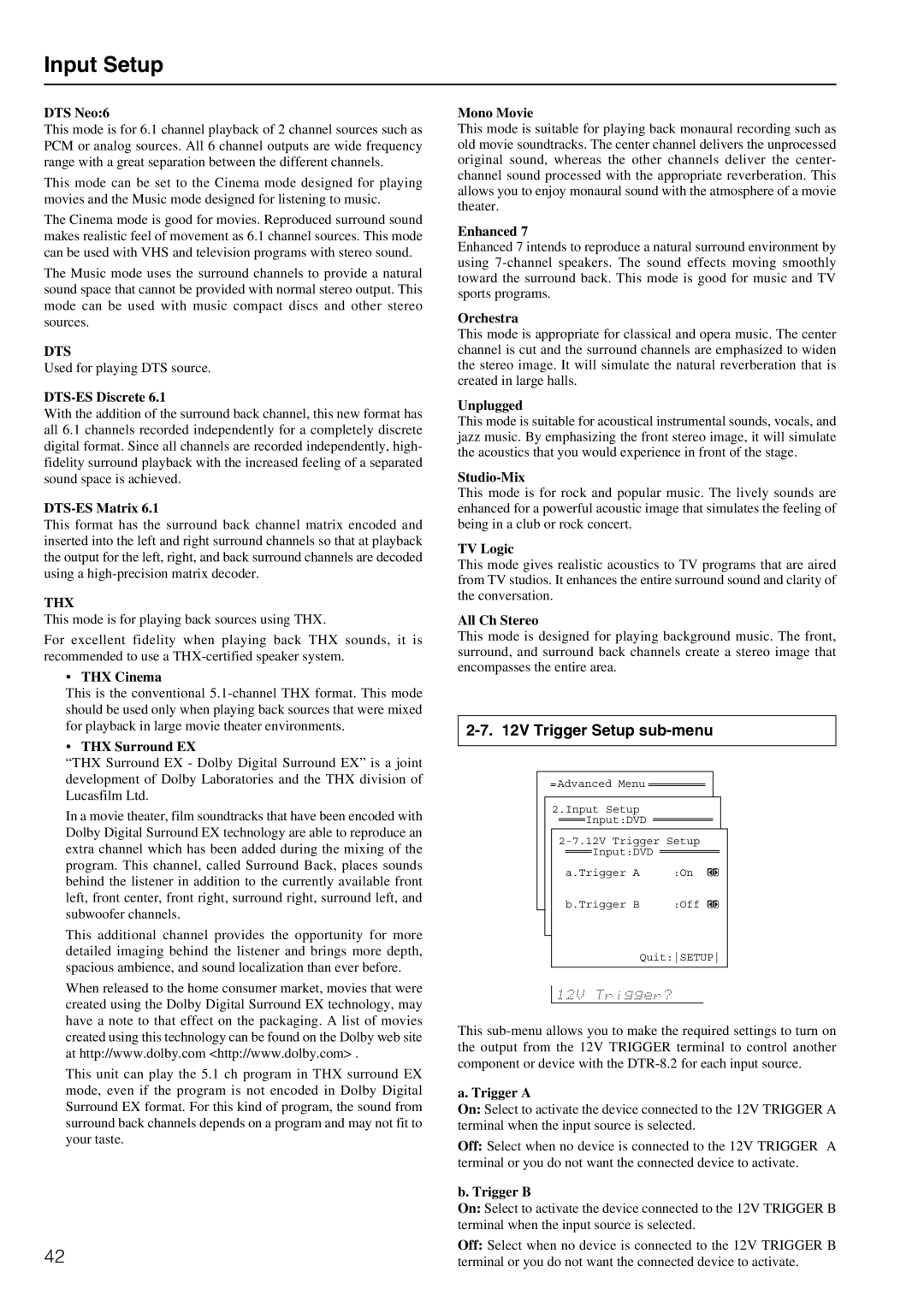DTS Neo:6
This mode is for 6.1 channel playback of 2 channel sources such as PCM or analog sources. All 6 channel outputs are wide frequency range with a great separation between the different channels.
This mode can be set to the Cinema mode designed for playing movies and the Music mode designed for listening to music.
The Cinema mode is good for movies. Reproduced surround sound makes realistic feel of movement as 6.1 channel sources. This mode can be used with VHS and television programs with stereo sound.
The Music mode uses the surround channels to provide a natural sound space that cannot be provided with normal stereo output. This mode can be used with music compact discs and other stereo sources.
DTS
Used for playing DTS source.
DTS-ES Discrete 6.1
With the addition of the surround back channel, this new format has all 6.1 channels recorded independently for a completely discrete digital format. Since all channels are recorded independently, high- fidelity surround playback with the increased feeling of a separated sound space is achieved.
DTS-ES Matrix 6.1
This format has the surround back channel matrix encoded and inserted into the left and right surround channels so that at playback the output for the left, right, and back surround channels are decoded using a high-precision matrix decoder.
THX
This mode is for playing back sources using THX.
For excellent fidelity when playing back THX sounds, it is recommended to use a THX-certified speaker system.
•THX Cinema
This is the conventional 5.1-channel THX format. This mode should be used only when playing back sources that were mixed for playback in large movie theater environments.
•THX Surround EX
“THX Surround EX - Dolby Digital Surround EX” is a joint development of Dolby Laboratories and the THX division of Lucasfilm Ltd.
In a movie theater, film soundtracks that have been encoded with Dolby Digital Surround EX technology are able to reproduce an extra channel which has been added during the mixing of the program. This channel, called Surround Back, places sounds behind the listener in addition to the currently available front left, front center, front right, surround right, surround left, and subwoofer channels.
This additional channel provides the opportunity for more detailed imaging behind the listener and brings more depth, spacious ambience, and sound localization than ever before.
When released to the home consumer market, movies that were created using the Dolby Digital Surround EX technology, may have a note to that effect on the packaging. A list of movies created using this technology can be found on the Dolby web site at http://www.dolby.com <http://www.dolby.com> .
This unit can play the 5.1 ch program in THX surround EX mode, even if the program is not encoded in Dolby Digital Surround EX format. For this kind of program, the sound from surround back channels depends on a program and may not fit to your taste.
42
Mono Movie
This mode is suitable for playing back monaural recording such as old movie soundtracks. The center channel delivers the unprocessed original sound, whereas the other channels deliver the center- channel sound processed with the appropriate reverberation. This allows you to enjoy monaural sound with the atmosphere of a movie theater.
Enhanced 7
Enhanced 7 intends to reproduce a natural surround environment by using 7-channel speakers. The sound effects moving smoothly toward the surround back. This mode is good for music and TV sports programs.
Orchestra
This mode is appropriate for classical and opera music. The center channel is cut and the surround channels are emphasized to widen the stereo image. It will simulate the natural reverberation that is created in large halls.
Unplugged
This mode is suitable for acoustical instrumental sounds, vocals, and jazz music. By emphasizing the front stereo image, it will simulate the acoustics that you would experience in front of the stage.
Studio-Mix
This mode is for rock and popular music. The lively sounds are enhanced for a powerful acoustic image that simulates the feeling of being in a club or rock concert.
TV Logic
This mode gives realistic acoustics to TV programs that are aired from TV studios. It enhances the entire surround sound and clarity of the conversation.
All Ch Stereo
This mode is designed for playing background music. The front, surround, and surround back channels create a stereo image that encompasses the entire area.
2-7. 12V Trigger Setup sub-menu
Advanced Menu 
2.Input Setup  Input:DVD
Input:DVD 
2-7.12V Trigger Setup
 Input:DVD
Input:DVD 
a.Trigger A | :On |
b.Trigger B | :Off |
| Quit:SETUP |
This sub-menu allows you to make the required settings to turn on the output from the 12V TRIGGER terminal to control another component or device with the DTR-8.2 for each input source.
a. Trigger A
On: Select to activate the device connected to the 12V TRIGGER A terminal when the input source is selected.
Off: Select when no device is connected to the 12V TRIGGER A terminal or you do not want the connected device to activate.
b. Trigger B
On: Select to activate the device connected to the 12V TRIGGER B terminal when the input source is selected.
Off: Select when no device is connected to the 12V TRIGGER B terminal or you do not want the connected device to activate.

